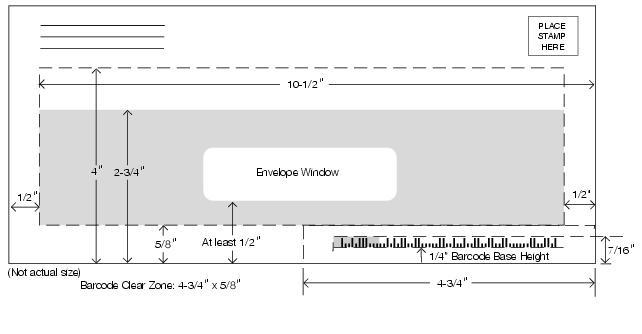|
Quick Service Guide 201a
Commercial Letters and Postcards
Designing Letters and Postcards for Automated Processing
May, 11 2009
Printer-Friendly PDF
Related QSGs

230d, First-Class Mail Automation Letters and Postcards
240c, Standard Mail Automation Letters
707f, Periodicals Barcoded (Automation) Letters
Overview

Letter-size mail and card-size pieces meeting the applicable automation standards are entitled to automation rates. This Quick Service Guide summarizes the standards for mail with 100% delivery point barcodes and mail without barcodes processed on USPS optical character readers (OCRs).

Must meet all physical standards in 201.3.0.
Aspect ratio from 1.3 to 2.5 (201.3.7).
Dimensions:
- Minimum: 3-1/2 inches high, 5 inches long, and either 0.007 inch thick if not more than 4-1/4 inches high and 6 inches long; or 0.009 inch thick if more than 4-1/4 inches high or 6 inches long, or both.
- Maximum for cards at card rates: 4-1/4 inches high, 6 inches long, and 0.016 inch thick.
- Maximum for letters and other cards: 6-1/8 inches high, 11-1/2 inches long, 1/4 inch thick.
- Rectangular, with four square corners and parallel opposite sides. Letter-size, card-type mailpieces made of cardstock may have finished corners that do not exceed a radius of 0.125 inch (1/8 inch).
Maximum Weight:
- First-Class Mail Presorted Machinable—3.3 ounces (0.2063 pound).
- First-Class Mail Automation—3.5 ounces (0.2188 pound).1
- Periodicals Barcoded (Automation)—3.5 ounces (0.2188 pound).1
- Standard Mail Automation—3.5 ounces (0.2188 pound).1
- Enhanced Carrier Route—3.5 ounces (0.2188 pound).1
1. Heavy letters over 3 ounces must bear an address block delivery point barcode under 201.3.14.4, be part of a 100% delivery point or Intelligent Mail barcoded mailing, and be prepared in a sealed envelope. Heavy letters may not contain stiff enclosures or be prepared as a self-mailer or booklet-type mailpiece.
Prohibitions:
- Polywrap, polybag, and shrinkwrap.
- Clasps, strings, staples, buttons, or protrusions that might impede or damage the mail or mail processing equipment (201.3.5).
Other machinability standards:
- Rigid and odd-shaped items prohibited or restricted (201.3.10).
Pieces with delivery point barcodes or Intelligent Mail barcodes must meet all standards in 708.4.0:
- Format of barcode bars (e.g., dimensions and spacing, 708.4.2).
- Minimum clearance around barcode for barcodes printed on a mailpiece or label: 1/8 inch on left and right sides; 1/25 inch above and below barcode.
- Placement of address block barcode, lower right barcode, or barcode within a window: see page two.
- Reflectance standards for barcode and portion of mailpiece on which barcode is printed (708.4.4).
Barcode in Address Block (202.5.0)

When the barcode is included as part of the address block the barcode must be placed in one of these positions:
- Above the address line containing the recipient's name.
- Below the city, state, and ZIP Code line.
- Above or below the keyline information.
- Above or below the optional endorsement line.
Physical Standards for Automation-Compatible Mail ( 201.3.0)
|
|
|
Barcode Location: delivery point barcode or Intelligent Mail barcode either within address block or within barcode clear zone in lower right corner of mailpiece ( 202.5.0).
Address Block Barcode: ( 202.5.0) Within address block (shown by dashed lines) must be:
- Rightmost bar—at least 1/2 inch from right edge of the mailpiece.
- Leftmost bar—less than 10-1/2 inches from right edge, and at least 1/2 inch from the left edge.
- Top of each bar—less than 4 inches from bottom edge of mailpiece.
- Bottom line in address block including barcode—at least 5/8 inch from bottom edge of the mailpiece.
The minimum clearance between the barcode and any information line above or below it within the address block must be at least 0.040 (1/25) inch for POSTNET barcode or 0.028 inch for an Intelligent Mail barcode. The separation between the barcode and the top line or bottom line of the address block must not exceed 0.625 (5/8) inch.
Recommended Address Placement:
On a letter-size piece, the recommended address placement is within the optical character reader (OCR) read area, which is a space on the address side of the mailpiece defined by these boundaries ( 202.2.1):
- Left: 1/2 inch from the left edge of the piece.
- Right: 1/2 inch from the right edge of the piece.
- Top: 2-3/4 inches from the bottom edge of the piece.
- Bottom: 5/8 inch from the bottom edge of the piece.
|
Envelope Window and Label Placement:
0.125 (1/8) inch—minimum clearance between leftmost and rightmost bars and any printing or window edge.
0.040 (1/25) inch—minimum clearance between POSTNET barcode and top and bottom edges of window.
0.028 inch—minimum clearance between Intelligent Mail barcode and top and bottom edges of window.
For envelope window, a clear space must be maintained when insert is moved to its full limits in each direction within envelope ( 202.5.0).
Address Label Barcode Placement:
0.125 (1/8) inch—minimum clearance between the barcode and the left and right edges of the address label.
0.040 (1/25) inch—minimum clearance between POSTNET barcode and top and bottom edges of address label.
0.028 inch—minimum clearance between Intelligent Mail barcode and top and bottom edges of address label.
|
For Barcode in Lower Right Corner Location: Leftmost bar between 4-1/4 inches and 3-1/2 inches from right edge ( 202.5.0).
Barcode Window: If the barcode is printed on an insert to appear through a window in the lower right corner, see 202.5.8.
|
Barcode Skew: The combined effects of positional skew (slant or tilt of the entire barcode baseline) and rotational skew (slant or tilt of the individual barcode bars) for a barcode on a card-size or a letter-size piece must be limited to a maximum rotation of the bars of �5 degrees from a perpendicular to the bottom edge of the piece. The individual bars of a barcode must not shift (be vertically offset) more than 0.015 inch from the average baseline of the barcode ( 708.4.4.1).
|
Back to Top
|




